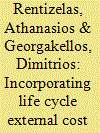|
|
|
Sort Order |
|
|
|
Items / Page
|
|
|
|
|
|
|
| Srl | Item |
| 1 |
ID:
125720


|
|
|
|
|
| Publication |
2013.
|
| Summary/Abstract |
The main purpose of this paper is to assess efficiency of the Brazilian electricity generation mix proposed in the 2020 Decennial Plan for Energy Expansion (DPEE 2020). It evaluates estimated costs, risks and CO2 emissions following the mean-variance portfolio theory. The efficiency frontier is estimated for three CO2 prices scenarios: no CO2 prices, low CO2 price and high CO2 price. The planned portfolio in Brazil presented in the DPEE 2020 is relatively close to the efficient frontier, however there is still room for risk mitigation by diversifying the energy portfolio. As there is currently no CO2 price in Brazil, the tendency is that diversification increases fossil fuel share in the energy mix, but the introduction of a CO2 price can be an option to promote renewables. This type of large general market framework can contribute to reduce market uncertainties by reducing the level of government's discretionary activism.
|
|
|
|
|
|
|
|
|
|
|
|
|
|
|
|
| 2 |
ID:
127202


|
|
|
|
|
| Publication |
2014.
|
| Summary/Abstract |
The present work aims to examine the strategic decision of future electricity generation mix considering, together with all other factors, the effect of the external cost associated with the available power generation technology options, not only during their operation but also during their whole life cycle. The analysis has been performed by integrating the Life Cycle Assessment concept into a linear programming model for the yearly decisions on which option should be used to minimize the electricity generation cost. The model has been applied for the case of Greece for the years 2012-2050 and has led to several interesting results. Firstly, most of the new generating capacity should be renewable (mostly biomass and wind), while natural gas is usually the only conventional fuel technology chosen. If externalities are considered, wind energy increases its share and hydro-power replaces significant amounts of biomass-generated energy. Furthermore, a sensitivity analysis has been performed. One of the most important findings is that natural gas increases its contribution when externalities are increased. Summing-up, external cost has been found to be a significant percentage of the total electricity generation cost for some energy sources, therefore significantly changing the ranking order of cost-competitiveness for the energy sources examined
|
|
|
|
|
|
|
|
|
|
|
|
|
|
|
|
| 3 |
ID:
177451


|
|
|
|
|
| Summary/Abstract |
This paper analyses how people’s attitudes towards onshore wind power and overhead transmission lines affect the cost-optimal development of electricity generation mixes, under a high renewable energy policy. A power systems generation and transmission expansion planning model is used for the analysis, combined with a novel additional modelling constraint incorporating public acceptance of energy infrastructure. In the scenarios examined the least cost solutions increase by as much as 33% compared to a base case where the constraint on public acceptance of energy infrastructure is excluded. In the most extreme public acceptance scenario considered, the greatest share of additional costs (>80%) is related to value of lost load, while additional investment and operational costs associated with public acceptance constraints for new energy infrastructure are between 5–6% of base case costs. The results are indicative of the cost that power systems face in reflecting the public’s preferences for new energy infrastructure in generation and grid expansion planning. Power system modelling that ignores the public’s acceptance of new energy infrastructure may offer generation or transmission pathways that are likely to be sub-optimal in practice.
|
|
|
|
|
|
|
|
|
|
|
|
|
|
|
|
| 4 |
ID:
101368


|
|
|
|
|
| Publication |
2011.
|
| Summary/Abstract |
Standalone levelised cost assessments of electricity supply options miss an important contribution that renewable and non-fossil fuel technologies can make to the electricity portfolio: that of reducing the variability of electricity costs, and their potentially damaging impact upon economic activity. Portfolio theory applications to the electricity generation mix have shown that renewable technologies, their costs being largely uncorrelated with non-renewable technologies, can offer such benefits. We look at the existing Scottish generation mix and examine drivers of changes out to 2020. We assess recent scenarios for the Scottish generation mix in 2020 against mean-variance efficient portfolios of electricity-generating technologies. Each of the scenarios studied implies a portfolio cost of electricity that is between 22% and 38% higher than the portfolio cost of electricity in 2007. These scenarios prove to be mean-variance "inefficient" in the sense that, for example, lower variance portfolios can be obtained without increasing portfolio costs, typically by expanding the share of renewables. As part of extensive sensitivity analysis, we find that Wave and Tidal technologies can contribute to lower risk electricity portfolios, while not increasing portfolio cost.
|
|
|
|
|
|
|
|
|
|
|
|
|
|
|
|
|
|
|
|
|